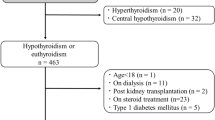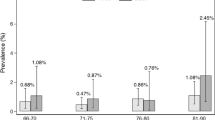Abstract
Hypothyroidism has been reported to be associated with chronic kidney disease (CKD). However, the impact of thyroid-stimulating hormone (TSH) on new onset of CKD and its gender dependence remain undetermined. We investigated the association of serum TSH level and the development of CKD defined by estimated glomerular filtration rate (eGFR) < 60 mL/min/1.73 m2 or positive for urine protein in 28,990 Japanese subjects who received annual health examinations. After excluding subjects with no data for serum TSH, urinalysis and eGFR and those with CKD at baseline, a total of 10,392 subjects (men/women: 6802/3590, mean age: 48 years) were recruited. During a 10-year follow-up, 1185 men (6.7%) and 578 women (2.9%) newly developed CKD. Multivariable Cox proportional hazard models after adjustment of age, body mass index, smoking habit, hypertension, diabetes mellitus, dyslipidemia, ischemic heart disease and eGFR (≥ 90 mL/min/1.73 m2) showed that the hazard ratio (HR) for the development of CKD in the high TSH (> 4.2 mU/L) group was significantly higher than that in the low TSH (≤ 4.2 mU/L) group in men (HR [95% confidence interval]: 1.41 [1.09–1.83]) but not in women (1.08 [0.77–1.51]). There was a significant interaction between sex and the category of TSH level for the development of CKD (p = 0.02). The adjusted HR with a restricted cubic spline increased with a higher level of TSH in men but not in women. In conclusion, a high level of TSH is associated with an increased risk for the development of CKD in men but not in women.

This is a preview of subscription content, access via your institution
Access options
Subscribe to this journal
Receive 12 print issues and online access
$259.00 per year
only $21.58 per issue
Buy this article
- Purchase on Springer Link
- Instant access to full article PDF
Prices may be subject to local taxes which are calculated during checkout


Similar content being viewed by others
References
Japanese Society of Nephrology. Essential points from Evidence-based Clinical Practice Guidelines for Chronic Kidney Disease 2018. Clin Exp Nephrol. 2019;23:1–15.
Stevens PE, Levin A. Kidney Disease: Improving Global Outcomes Chronic Kidney Disease Guideline Development Work Group M. Evaluation and management of chronic kidney disease: synopsis of the kidney disease: improving global outcomes 2012 clinical practice guideline. Ann Intern Med. 2013;158:825–30.
Matsushita K, Ballew SH, Wang AY, Kalyesubula R, Schaeffner E, Agarwal R. Epidemiology and risk of cardiovascular disease in populations with chronic kidney disease. Nat Rev Nephrol. 2022;18:696–707.
Webster AC, Nagler EV, Morton RL, Masson P. Chronic Kidney Disease. Lancet. 2017;389:1238–52.
Yamagata K, Ishida K, Sairenchi T, Takahashi H, Ohba S, Shiigai T, et al. Risk factors for chronic kidney disease in a community-based population: a 10-year follow-up study. Kidney Int. 2007;71:159–66.
Di Mauro M, Fiorentini V, Mistrulli R, Veneziano FA, De Luca L. Acute coronary syndrome and renal impairment: a systematic review. Rev Cardiovasc Med. 2022;23:49.
Takahashi S, Tanaka M, Furuhashi M, Moniwa N, Koyama M, Higashiura Y, et al. Fatty liver index is independently associated with deterioration of renal function during a 10-year period in healthy subjects. Sci Rep. 2021;11:8606.
Osanami A, Tanaka M, Furuhashi M, Ohnishi H, Hanawa N, Yamashita T, et al. Increased LDL-cholesterol level is associated with deterioration of renal function in males. Clin Kidney J. 2022;15:1888–95.
Tanaka M, Mori K, Takahashi S, Higashiura Y, Ohnishi H, Hanawa N, et al. Metabolic dysfunction-associated fatty liver disease predicts new onset of chronic kidney disease better than fatty liver or nonalcoholic fatty liver disease. Nephrol Dial Transpl. 2023;38:700–11.
Mullur R, Liu YY, Brent GA. Thyroid hormone regulation of metabolism. Physiol Rev. 2014;94:355–82.
Sheehan MT. Biochemical Testing of the Thyroid: TSH is the Best and, Oftentimes, Only Test Needed - A Review for Primary Care. Clin Med Res. 2016;14:83–92.
Khan R, Sikanderkhel S, Gui J, Adeniyi AR, O’Dell K, Erickson M, et al. Thyroid and Cardiovascular Disease: A Focused Review on the Impact of Hyperthyroidism in Heart Failure. Cardiol Res. 2020;11:68–75.
Mariani LH, Berns JS. The renal manifestations of thyroid disease. J Am Soc Nephrol. 2012;23:22–6.
Lo JC, Chertow GM, Go AS, Hsu CY. Increased prevalence of subclinical and clinical hypothyroidism in persons with chronic kidney disease. Kidney Int. 2005;67:1047–52.
Chonchol M, Lippi G, Salvagno G, Zoppini G, Muggeo M, Targher G. Prevalence of subclinical hypothyroidism in patients with chronic kidney disease. Clin J Am Soc Nephrol. 2008;3:1296–300.
Rhee CM, Kalantar-Zadeh K, Streja E, Carrero JJ, Ma JZ, Lu JL, et al. The relationship between thyroid function and estimated glomerular filtration rate in patients with chronic kidney disease. Nephrol Dial Transpl. 2015;30:282–7.
Hataya Y, Igarashi S, Yamashita T, Komatsu Y. Thyroid hormone replacement therapy for primary hypothyroidism leads to significant improvement of renal function in chronic kidney disease patients. Clin Exp Nephrol. 2013;17:525–31.
Uchiyama-Matsuoka N, Tsuji K, Uchida HA, Kitamura S, Itoh Y, Nishiyama Y, et al. Masked CKD in hyperthyroidism and reversible CKD status in hypothyroidism. Front Endocrinol (Lausanne). 2022;13:1048863.
Fang H, Zhao R, Cui S, Wan W. Sex differences in major cardiovascular outcomes and fractures in patients with subclinical thyroid dysfunction: a systematic review and meta-analysis. Aging (Albany NY). 2022;14:8448–85.
Matsuo S, Imai E, Horio M, Yasuda Y, Tomita K, Nitta K, et al. Revised equations for estimated GFR from serum creatinine in Japan. Am J Kidney Dis. 2009;53:982–92.
Hishinuma A. TSH Reference Interval Study in Japan. https://www.japanthyroid.jp/common/20200130_tsh_e.pdf.
Thienpont LM, Van Uytfanghe K, De Grande LAC, Reynders D, Das B, Faix JD, et al. Harmonization of Serum Thyroid-Stimulating Hormone Measurements Paves the Way for the Adoption of a More Uniform Reference Interval. Clin Chem. 2017;63:1248–60.
Araki E, Goto A, Kondo T, Noda M, Noto H, Origasa H, et al. Japanese Clinical Practice Guideline for Diabetes 2019. J Diabetes Investig. 2020;11:1020–76.
Umemura S, Arima H, Arima S, Asayama K, Dohi Y, Hirooka Y, et al. The Japanese Society of Hypertension Guidelines for the Management of Hypertension (JSH 2019). Hypertens Res. 2019;42:1235–481.
Kanda Y. Investigation of the freely available easy-to-use software ‘EZR’ for medical statistics. Bone Marrow Transpl. 2013;48:452–8.
Jonklaas J, Bianco AC, Bauer AJ, Burman KD, Cappola AR, Celi FS, et al. Guidelines for the treatment of hypothyroidism: prepared by the american thyroid association task force on thyroid hormone replacement. Thyroid. 2014;24:1670–751.
Chaker L, Sedaghat S, Hoorn EJ, Elzen WP, Gussekloo J, Hofman A, et al. The association of thyroid function and the risk of kidney function decline: a population-based cohort study. Eur J Endocrinol. 2016;175:653–60.
Zhang Y, Chang Y, Ryu S, Cho J, Lee WY, Rhee EJ, et al. Thyroid hormone levels and incident chronic kidney disease in euthyroid individuals: the Kangbuk Samsung Health Study. Int J Epidemiol. 2014;43:1624–32.
Toda A, Hara S, Kato M, Tsuji H, Arase Y. Association of Thyrotropin Concentration with Chronic Kidney Disease in a Japanese General Population Cohort. Nephron. 2019;142:91–7.
Valdivielso JM, Jacobs-Cacha C, Soler MJ. Sex hormones and their influence on chronic kidney disease. Curr Opin Nephrol Hypertens. 2019;28:1–9.
Hutchens MP, Fujiyoshi T, Komers R, Herson PS, Anderson S. Estrogen protects renal endothelial barrier function from ischemia-reperfusion in vitro and in vivo. Am J Physiol Ren Physiol. 2012;303:F377–85.
Maric C, Sandberg K, Hinojosa-Laborde C. Glomerulosclerosis and tubulointerstitial fibrosis are attenuated with 17beta-estradiol in the aging Dahl salt sensitive rat. J Am Soc Nephrol. 2004;15:1546–56.
Ruiz-Larrea MB, Leal AM, Martin C, Martinez R, Lacort M. Antioxidant action of estrogens in rat hepatocytes. Rev Esp Fisiol. 1997;53:225–9.
Baylis C. Sexual dimorphism in the aging kidney: differences in the nitric oxide system. Nat Rev Nephrol. 2009;5:384–96.
Carrero JJ, Hecking M, Chesnaye NC, Jager KJ. Sex and gender disparities in the epidemiology and outcomes of chronic kidney disease. Nat Rev Nephrol. 2018;14:151–64.
Yasui T, Hayashi K, Mizunuma H, Kubota T, Aso T, Matsumura Y, et al. Factors associated with premature ovarian failure, early menopause and earlier onset of menopause in Japanese women. Maturitas. 2012;72:249–55.
Klein I, Danzi S. Thyroid disease and the heart. Circulation. 2007;116:1725–35.
Vargas F, Rodriguez-Gomez I, Vargas-Tendero P, Jimenez E, Montiel M. The renin-angiotensin system in thyroid disorders and its role in cardiovascular and renal manifestations. J Endocrinol. 2012;213:25–36.
Narasaki Y, Sohn P, Rhee CM. The Interplay Between Thyroid Dysfunction and Kidney Disease. Semin Nephrol. 2021;41:133–43.
Poll BG, Chen L, Chou CL, Raghuram V, Knepper MA. Landscape of GPCR expression along the mouse nephron. Am J Physiol Ren Physiol. 2021;321:F50–F68.
Vieira IH, Rodrigues D, Paiva I. The Mysterious Universe of the TSH Receptor. Front Endocrinol (Lausanne). 2022;13:944715.
Sellitti DF, Akamizu T, Doi SQ, Kim GH, Kariyil JT, Kopchik JJ, et al. Renal expression of two ‘thyroid-specific’ genes: thyrotropin receptor and thyroglobulin. Exp Nephrol. 2000;8:235–43.
Acknowledgements
The authors are grateful to Keita Numata and Takashi Hisasue for data management and Tomoyuki Tanaka for provision for information of measurement system for TSH.
Funding
M.T and M.F were supported by JSPS KAKENHI (22K08313, 23K07993).
Author information
Authors and Affiliations
Contributions
KE, MT and MF designed the study, performed data collection and statistical analyses, and wrote the paper. TS, KM, IH, TM, AU and NH performed data collection. YA and HO performed the statistical analyses. All authors approved the final version of the manuscript.
Corresponding author
Ethics declarations
Conflict of interest
The authors declare no competing interests.
Additional information
Publisher’s note Springer Nature remains neutral with regard to jurisdictional claims in published maps and institutional affiliations.
Supplementary information
Rights and permissions
Springer Nature or its licensor (e.g. a society or other partner) holds exclusive rights to this article under a publishing agreement with the author(s) or other rightsholder(s); author self-archiving of the accepted manuscript version of this article is solely governed by the terms of such publishing agreement and applicable law.
About this article
Cite this article
Endo, K., Tanaka, M., Sato, T. et al. A high level of thyroid-stimulating hormone is a risk factor for the development of chronic kidney disease in men: a 10-year cohort study. Hypertens Res 47, 663–671 (2024). https://doi.org/10.1038/s41440-023-01453-1
Received:
Revised:
Accepted:
Published:
Issue Date:
DOI: https://doi.org/10.1038/s41440-023-01453-1
Keywords
This article is cited by
-
Preface-various factors in the management of blood pressure
Hypertension Research (2024)



